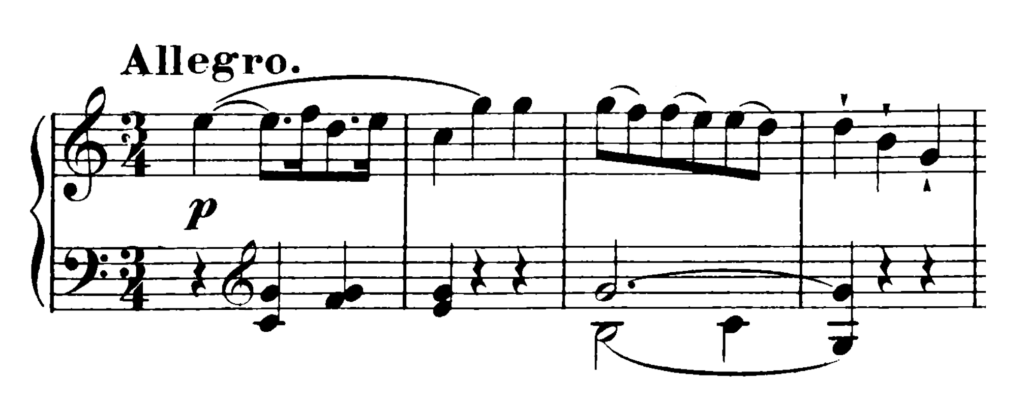Analysis
Contents
First Movement (Allegro Con Brio)
Form: Sonata Form. C Major.
EXPOSITION (Bars 1-68):
Bars 1-13: First Subject. Tonic key, C Major, ends with Imperfect Cadence.
Bars 13-36: Bridge Passage or Episode. Built upon Material of First Subject with triplet accompaniment. Commencing in C Major, modulates to F Major (Bar 17), G Major (Bar 24), D Major (Bar 32), G Major (Bar 34), to end with Imperfect Cadence.
Bars 37-68: Second Subject. Dominant key, G Major. Frequent use of Chromatic Passing Notes, ends with Perfect Cadence.
Double Bar and Repeat.
DEVELOPMENT (Bars 69-105):
Bars 69-72: Commences with the opening figure of First Subject in Tonic key, C Major (Bar 69), moves to A minor (Bar 73).
Bars 73-105: Material of Bridge Passage enters in F Major (Bar 73), moves to Dominant key, G Major (Bar 83), A minor (Bar 84), to F Major (Bar 91), then to E minor (Bar 94), A minor with Dominant pedal-point (Bars 96-99), Chords of Dominant minor 9th (Bar 102) in D minor leads to Tonic key, C Major (Bar 104). Development ends with Chord of the Dominant 7th in C Major.
RECAPITULATION (Bars 105-172):
Bars 105-124: First Subject. Tonic key, C Major, elaborated and extended to end with Imperfect Cadence (Bar 124). Touches C minor (Bar 113), D minor (Bar 116), C Major (Bar 120).
Bars 125-127: Bridge Passage or Episode is omitted and Bars 125-127 just form a link between the Two Subjects.
Bars 127-153: Second Subject. Tonic key, C Major, ends with Supertonic Chromatic minor 9th of that key (Bar 153).
Bars 154-172: Coda. Tonic key, C Major. Built upon Material of First Subject, ends with Perfect Cadence.
Second Movement (Adagio)
Form: Binary Form. F Major.
Part I (Bars 1-21):
Bars 1-8: THEME I. Tonic key, F Major, ends with Imperfect Cadence.
Bars 9-17.5: THEME II. Commences in Dominant key, C Major (Bar 9), moves to Tonic key, F Major (Bar 13), returning to C Major (Bar 14) and ending with a Perfect Cadence (Bars 16-17).
Bars 17-21: Coda. Ends with Perfect Cadence and double suspension in C Major.
Double Bar and Repeat.
Part II (Bars 21-42):
Bars 21-29: THEME I. Tonic key, F Major, passes through G minor (Bar 24), F Major (Bar 26), to C Major (Bar 28), to end with Perfect Cadence in Dominant key, C Major (Bar 29).
Bars 30-38: THEME II. Commences in Tonic key, F Major, touches the Sub-dominant key, B flat Major (Bar 34), returns to F Major (Bar 35), to end with Perfect Cadence (Bar 38).
Bars 38-42: Coda. Ends with Perfect Cadence and double suspension in Tonic key, F Major.
Third Movement (Allegro)
Form: Rondo Form. C Major.
Principle Theme at its opening and closing entries is in Ternary form (A B A). Its appearance after Episode 1 is in the “A” section only.
Principle Theme. Tonic key, C Major (Bars 1-25)
Bars 1-8: A. C Major ends with Perfect Cadence. Double Bar and Repeat.
Bars 9-17: B. G Major ends with Perfect Cadence.
Bars 18-25: A. C Major ends with Perfect Cadence. Double Bar and Repeat.
EPISODE I (Bars 26-53):
Bars 26-45: Commences in G Major (dominant key) with Material of Principle Theme and then develops into a triplet figure (Bar 33), returning to the Material of Principle Theme in F Major (Bar 40), D minor (Bar 42), G Major (Bar 44), Perfect Cadence (Bars 44-45).
Bars 46-53: Principle Theme. First Section only in Tonic key, C Major. Double Bar and Repeat.
EPISODE II (Bars 54-70):
Bars 54-60: New Material in Tonic minor key, C minor, modulates to E flat Major (Bar 59).
Bar 61: Double Bar and Repeat.
Bars 62-70: Returning to C minor (Bars 64), ending with Imperfect Cadence in that key at Bar 70. Double Bar and no Repeat.
Principle Theme. (Bars 71-98)
Bars 71-78: A. Tonic key, C Major.
Bars 79-86: B. C Major to G Major.
Bars 18-25: A. Altered to form Coda and Cadence in Tonic key, C Major.









